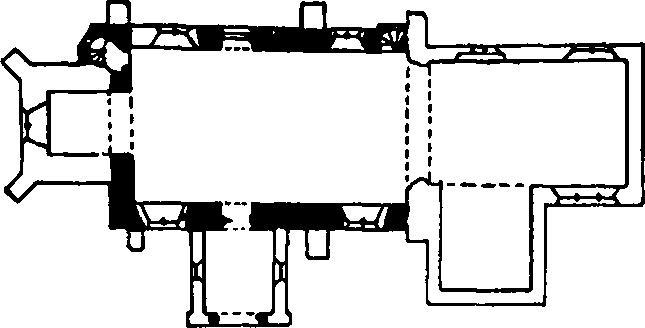An Inventory of the Historical Monuments in Essex, Volume 3, North East. Originally published by His Majesty's Stationery Office, London, 1922.
This free content was digitised by double rekeying. All rights reserved.
'Great Wigborough', in An Inventory of the Historical Monuments in Essex, Volume 3, North East(London, 1922), British History Online https://prod.british-history.ac.uk/rchme/essex/vol3/pp133-134 [accessed 10 May 2025].
'Great Wigborough', in An Inventory of the Historical Monuments in Essex, Volume 3, North East(London, 1922), British History Online, accessed May 10, 2025, https://prod.british-history.ac.uk/rchme/essex/vol3/pp133-134.
"Great Wigborough". An Inventory of the Historical Monuments in Essex, Volume 3, North East. (London, 1922), British History Online. Web. 10 May 2025. https://prod.british-history.ac.uk/rchme/essex/vol3/pp133-134.
In this section
42. GREAT WIGBOROUGH. (C.d.)
(O.S. 6 in. (a)xxxvi. S.E. (b)xlvi. N.E.)
Great Wigborough is a parish 7 m. S. of Colchester.
Ecclesiastical
b(1). Parish Church of St. Stephen stands towards the N. end of the parish. The walls are of mixed rubble and septaria with dressings of limestone; the roofs are tiled. The Nave and chancel were built late in the 14th century. Late in the 15th century a W. tower and a S. porch were added. The church was seriously damaged by the earthquake of 1884, and was subsequently restored; the Chancel and West Tower being rebuilt and the South Vestry added. The South Porch was rebuilt in 1903.

The Church, Plan
Architectural Description — The Chancel is modern except for some reused material of the 14th century in the N.E. and S.E. windows.
The Nave (37½ ft. by 21 ft.) has in the N. wall two windows; the eastern is modern except for the reset 14th-century splays and rear-arch; the western window is modern; between them is the late 14th-century N. doorway, with moulded two-centred arch and label and defaced head-stops; it has been partly reset and is now blocked; at the E. end of the wall is the late 14th-century rood-loft staircase; the lower doorway has hollowchamfered jambs and two-centred head; the upper doorway has a round head and has been reset and partly restored. In the S. wall are two windows, both modern except for the W. splay of the eastern window; between them is the mid 15th-century S. doorway with a moulded two-centred arch and label with defaced head-stops; the moulded jambs have each an attached shaft, with moulded capital and base; above the doorway externally is a rough arch of doubtful purpose.
The West Tower has been almost entirely rebuilt but incorporates much of the late 15th-century material. The two-centred tower-arch is of two hollow-chamfered orders, the outer continuous and the inner dying on to the side walls. The W. window incorporates some old work in the jambs and splays.
The South Porch was rebuilt in 1903 but incorporates late 15th-century material. The two-centred outer archway is of two moulded orders, the outer continuous and the inner resting on attached shafts with moulded capitals and bases. The side walls have each a window, mostly modern but incorporating in one the head of two trefoiled lights with a moulded label and in the other some stones in the jambs.
The Roof of the nave is modern but incorporates some 15th or early 16th-century timbers, including a moulded principal and moulded and carved wallplates.
Fittings—Bells: two; 1st by John Danyell, inscribed "Nomen Magdalene Campana Geret Melodie," late 15th-century; 2nd by Miles Graye, 1622. Brass: In nave—on N. wall, to Henry Bullocke, 1609, inscription only; indent of this brass now forms threshold of S. doorway. Door: In tower—in doorway to turret, of overlapping battens with strap-hinges, 15th-century. Font: octagonal bowl with moulded upper and lower edges, panelled sides, four with quatrefoils enclosing blank shields, two with roses, the others with a pair of feathers and a heart respectively, each with a scroll, buttressed stem, 15th-century, lower part of stem and the base modern. Floor-slabs: In chancel—(1) to Henry Bullocke, 1628. In nave— (2) to Ann, widow of Edward Marke, 1621; (3) to Richard Wiseman, 1616. Niche: In nave—in N. wall, W. of N.E. window, with shafted jambs and ribbed vault, moulded pedestal, late 15th-century, much defaced. Plate: includes cup probably of late 16th-century date and remodelled, with knop and cone-shaped stem; late 16th-century cover-paten with incised ornament. Stoups: In nave—adjoining N. doorway, with chamfered jambs and two-centred head, probably 15th-century and reset; adjoining S. doorway, similar to above but in situ. Miscellanea: In splay of S. doorway— stone with 12th-century ornament. In churchyard—S. of tower, various worked stones, 14th or 15th-century.
Condition—Poor, serious cracks in walls.
Secular
b(2). Hyde Farm, house, 220 yards W. of the church, is of two storeys, partly timber-framed and partly of brick; the roofs are tiled. It was built in the 15th century with a central hall and crosswings at the E. and W. ends. Built into the E. chimney-stack is a gargoyle from Little Wigborough church. Inside the building the hall has been divided into two storeys in the 16th century, but retains an original king-post roof-truss. The fireplace in the main chimney-stack has a four-centred head of the 16th century and in the E. wall of the hall is a doorway with chamfered jambs and four-centred head. There are remains of the original roof construction in the E. wing.
Condition—Good, much altered.
b(3). Abbot's Hall, ¾ m. S.S.W. of the church, has been practically rebuilt, but the kitchen has 17th-century ceiling-beams and joists, apparently part of the original building.
Condition—Good, rebuilt.
a(4). Moulsham's Farm, house, 300 yards N.E. of the church, is of two storeys, timber-framed and plastered; the roofs are tiled. It was built early in the 17th century and has a late 17th-century addition on the W. side and modern additions both on the E. and W. Inside the building one room is lined with original panelling and there are some exposed ceiling-beams.
Condition—Good.
Unclassified
b(5). Red Hills, several near Abbot's Hall saltings, about 1 m. S. of the church.